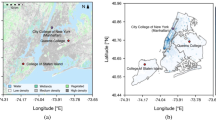Abstract
Very few attempts have so far been made to quantify the momentum and turbulent kinetic energy (TKE) budgets within real urban canopies. In this study, sonic anemometer data obtained during the Joint Urban 2003 field campaign in Oklahoma City, U.S.A. were used for calculating the momentum and TKE budgets within a real-world urban street canyon. Sonic anemometers were deployed on multiple towers in the lower half of the canyon. Gradients in all three principal directions were included in the analyses. The storage and buoyancy terms were found to have negligible contributions to both the momentum and TKE budgets. The momentum budgets were generally found to be more complex than a simple balance of two physical processes. The horizontal terms were found to have significant and sometimes dominant contributions to the momentum and TKE budgets.
Similar content being viewed by others
References
Allwine KJ, Leach MJ, Stockham LW, Shinn JS, Hosker RP, Bowers JF, Pace JC (2004) Overview of Joint Urban 2003—an atmospheric dispersion study in Oklahoma City. In: Proceedings of the symposium on planning, nowcasting and forecast urban zone, American Meteorological Society, Seattle, WA, USA, p J7.1
Belcher SE (2005) Mixing and transport in urban areas. Philos Trans Roy Soc A 363: 2947–2968
Bentham T, Britter R (2003) Spatially averaged flow within obstacle arrays. Atmos Environ 37: 2037–2043
Brown MJ, Boswell D, Streit G, Nelson M, McPherson T, Hilton T, Pardyjak ER, Pol S, Ramamurthy P, Hansen B, Kastner-Klein P, Clark J, Moore A, Felton N, Strickland D, Brook D, Princevac M, Zajic D, Wayson R, MacDonald J, Fleming G, Storwold D (2004) Joint Urban 2003 street canyon experiment. In: Proceedings of the symposium on planning, nowcasting and forecast urban zone, American Meteorological Society, Seattle, WA, USA, p J7.3
Burian S, Han W, Brown M (2003) Morphological analyses using 3D building databases: Oklahoma City, Oklahoma. Technical Report, LA-UR-05-1821, LANL, Los Alamos NM, USA, 64 pp
Chapra SC, Canale RP (1998) Numerical methods for engineers, 3rd edn. McGraw-Hill Companies, Boston, p 960
Cheng H, Castro IP (2002) Near wall flow over urban-like roughness. Boundary-Layer Meteorol 104: 229–259
Christen A, Rotach MW, Vogt R (2009) The budget of turbulent kinetic energy in the urban roughness sublayer. Boundary-Layer Meteorol 131: 193–222
Dobre A, Arnold SJ, Smalley RJ, Boddy JWD, Barlow JF, Tomlin AS, Belcher SE (2005) Flow field measurements in the proximity of an urban intersection in London, UK. Atmos Environ 39: 4647–4657
Gash JHC, Dolman AJ (2003) Sonic anemometer (co)sine response and flux measurement I. The potential for (co)sine error to affect sonic anemometer-based flux measurements. Agric For Meteorol 119: 195–207
Gayev YA, Savory E (1999) Influence of street obstructions on flow processes within urban canyons. J Wind Eng Ind Aerodyn 82: 89–103
Grimmond CSB, Oke TR (1999) Aerodynamic properties of urban areas derived from analysis of surface form. J Appl Meteorol 38: 1262–1292
Hignett P (1992) Corrections to temperature measurements with a sonic anemometer. Boundary-Layer Meteorol 61: 175–187
Klein P, Clark JV (2007) Flow variability in a North American downtown street canyon. J Appl Meteorol Climatol 46(6): 851–877
Klein P, Leitl B, Schatzmann M (2007) Driving physical mechanisms of flow and dispersion in urban canopies. Int J Climatol 27(14): 1887–1907
Leitl B, Schatzmann M (2005) Generation of wind tunnel data sets in support of the Joint Urban 2003 atmospheric dispersion study, Oklahoma City, July 2003—final report phase II 07-2005. Technical Report, Hamburg University, Hamburg, Germany. https://ju2003-dpg.dpg.army.mil/
Louka P, Belcher SE, Harrison RG (2000) Coupling between air flow in streets and the well-developed boundary layer aloft. Atmos Environ 34: 2613–2621
MacDonald RW (2000) Modelling the mean velocity profile in the urban canopy layer. Boundary-Layer Meteorol 97: 25–45
Nakamura Y, Oke TR (1988) Wind, temperature and stability conditions in an east–west oriented urban canyon. Atmos Environ 22(12): 2691–2700
Nelson MA, Pardyjak ER, Klewicki JC, Brown MJ (2007a) Properties of the wind field within the Oklahoma City Park Avenue street canyon. Part II: Spectra, co-spectra and quadrant analyses. J Appl Meteorol Climatol 46: 2055–2073
Nelson MA, Pardyjak ER, Klewicki JC, Pol SU, Brown MJ (2007b) Properties of the wind field within the Oklahoma City Park Avenue street canyon. Part I: Mean flow and turbulence statistics. J Appl Meteorol Climatol 46: 2038–2054
Panofsky HA, Dutton JA (1984) Atmospheric turbulence. Wiley, New York, p 397
Pol SU, Brown MJ (2006) Flow patterns at the ends of a street canyon: measurements from the Joint Urban 2003 field experiment. In: Sixth symposium on the urban environment 14th joint conference on the applications of air pollution meteorology with the air and waste management association, American Meteorological Society, Atlanta, GA, USA
Ramamurthy P, Pardyjak ER, Klewicki JC (2007) Observations of the effects of atmospheric stability on turbulence statistics deep within an urban street canyon. J Appl Meteorol Climatol 46(12): 2074–2085
Roth M (2000) Review of atmospheric turbulence over cities. Q J R Meteorol Soc 126: 941–990
Schotanus P, Nieuwstadt FTM, De Bruin HAR (1983) Temperature measurement with a sonic anemometer and its application to heat and moisture fluxes. Boundary-Layer Meteorol 26: 81–93
Stull RB (1988) An introduction to boundary layer meteorology. Kluwer, Dordrecht, p 670
Taylor GI (1938) The spectrum of turbulence. Proc Roy Soc Lond A 164(919): 476–490
Van der Mollen MK, Gash JHC, Elbers JA (2004) Sonic anemometer (co)sine response and flux measurement II. The effect of introducing an angle of attack dependent calibration. Agric For Meteorol 122: 95–109
Wyngaard JC, Clifford SF (1977) Taylor’s hypothesis and high frequency turbulence spectra. J Atmos Sci 34: 922–929
Yeung PK, Zhou Y (1997) On the universality of the Kolmogorov constant in numerical simulations of turbulence. Technical Report, NASA/CR-97-206251, ICASE Report No. 97-64, NASA, Langley Research Center, Hampton, 16 pp
Author information
Authors and Affiliations
Corresponding author
Rights and permissions
About this article
Cite this article
Nelson, M.A., Pardyjak, E.R. & Klein, P. Momentum and Turbulent Kinetic Energy Budgets Within the Park Avenue Street Canyon During the Joint Urban 2003 Field Campaign. Boundary-Layer Meteorol 140, 143–162 (2011). https://doi.org/10.1007/s10546-011-9610-8
Received:
Accepted:
Published:
Issue Date:
DOI: https://doi.org/10.1007/s10546-011-9610-8




